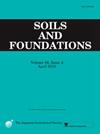Triggering mechanism of long-distance flow-type landslides caused by 2018 Sulawesi Earthquake, Indonesia
IF 3.3
2区 工程技术
Q2 ENGINEERING, GEOLOGICAL
引用次数: 0
Abstract
On 28 September 2018, the Mw 7.5 Sulawesi earthquake occurred in Indonesia, triggering long-distance flow-type landslides on very gentle slopes in and around Palu City. In order to investigate the triggering mechanism of these landslides, this study firstly compiled the field investigations that have been conducted since immediately after the earthquake and a soil profile of the landslide areas. Secondly, a groundwater flow analysis was carried out for the landslide in Petobo on the basis of the estimated soil cross-section. The results showed that, prior to the 2018 earthquake, there was confined groundwater with a water pressure of 40–60 kPa above what would be expected from the hydrostatic conditions in the flow zone of the landslide area. Finally, a simplified liquefaction analysis was performed using the groundwater pressure obtained by the groundwater flow analysis. The results indicated that, although the flow zone in the landslide area consisted of subsoils, including a relatively dense silty sand layer, it is likely that the significant liquefaction that occurred during the 2018 earthquake was due to the presence of confined groundwater. Furthermore, the authors concluded that the liquefaction probably contributed to the prolonged upward flow of large quantities of confined groundwater from aquifers located more than 20 m in depth below the ground surface, which resulted in a long-distance flow-type landslide by muddying the surface layer. It was also shown that the presence of an irrigation channel just above the landslide areas on the eastern side of Palu Valley had little effect on the sequence of landslide mechanism.
2018年印尼苏拉威西地震长距离流型滑坡触发机制研究
2018年9月28日,印度尼西亚苏拉威西岛发生7.5级地震,在帕卢市及其周边非常平缓的斜坡上引发了长距离流型滑坡。为了探讨滑坡的触发机制,本研究首先整理了地震发生后立即进行的现场调查和滑坡区土壤剖面。其次,在估算土壤截面的基础上,对Petobo滑坡进行了地下水流量分析。结果表明:2018年地震前,滑坡区流区存在承压地下水,水压高于静水条件预期值40 ~ 60 kPa。最后,利用地下水流量分析得到的地下水压力进行简化液化分析。结果表明,虽然滑坡区内的流动带由底土组成,包括相对致密的粉砂层,但2018年地震期间发生的显著液化很可能是由于承压地下水的存在。此外,作者得出结论,液化可能导致大量承压地下水从地表以下20 m以上的含水层长时间向上流动,从而使表面层变得泥泞,从而导致长距离流型滑坡。研究还表明,帕卢河谷东侧滑坡区上方存在灌溉渠,对滑坡机制的顺序影响不大。
本文章由计算机程序翻译,如有差异,请以英文原文为准。
求助全文
约1分钟内获得全文
求助全文
来源期刊

Soils and Foundations
工程技术-地球科学综合
CiteScore
6.40
自引率
8.10%
发文量
99
审稿时长
5 months
期刊介绍:
Soils and Foundations is one of the leading journals in the field of soil mechanics and geotechnical engineering. It is the official journal of the Japanese Geotechnical Society (JGS)., The journal publishes a variety of original research paper, technical reports, technical notes, as well as the state-of-the-art reports upon invitation by the Editor, in the fields of soil and rock mechanics, geotechnical engineering, and environmental geotechnics. Since the publication of Volume 1, No.1 issue in June 1960, Soils and Foundations will celebrate the 60th anniversary in the year of 2020.
Soils and Foundations welcomes theoretical as well as practical work associated with the aforementioned field(s). Case studies that describe the original and interdisciplinary work applicable to geotechnical engineering are particularly encouraged. Discussions to each of the published articles are also welcomed in order to provide an avenue in which opinions of peers may be fed back or exchanged. In providing latest expertise on a specific topic, one issue out of six per year on average was allocated to include selected papers from the International Symposia which were held in Japan as well as overseas.
 求助内容:
求助内容: 应助结果提醒方式:
应助结果提醒方式:


